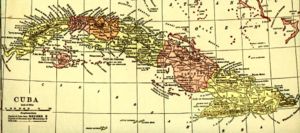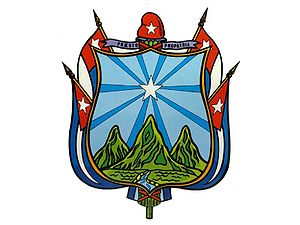- Oriente Province
-
Oriente (Spanish for "East") was one of six provinces of Cuba until 1976. It was known as "Santiago de Cuba Province" before 1905. The name is still used to refer to the eastern part of the country. The provincial capital was Santiago de Cuba. Fidel and Raúl Castro were born there.
The province was split up in 1976, with the administrative re-adjustment proclaimed by Cuban Law Number 1304 of July 3, 1976.[1]
The territory of "Oriente" is nowadays represented by 5 provinces:
Contents
History
Diego Velazquez founded the capital of Oriente province in 1514 and named it Santiago de Cuba. The province is made up by 22 municipalities and is Cuba’s largest province containing about one third of the country’s population. Oriente Province is in the most eastern region of Cuba with a population of 1,797,606.[2] It stretches across 14,641 square miles (37,920 km2) [3] and consists of various mountain ranges with the Sierra Maestra region having Cuba’s highest mountain peak and elevation in Pico Turquino. Oriente Province holds much of Cuba’s history being the place of Fidel and Raul Castro’s birth, Jose Marti was killed in battle in Dos Rios and many guerilla wars have also taken place in Oriente like the Bay of Pigs. Cuba’s first Guerilla-style war was in 1523.[4] against the conquering Spaniards in the Sierra Maestra Mountains. Some of Cuba’s oldest cities are in Oriente Province like Baracoa and carry a rich history of Cuba’s struggle for independence and racial relations.
Throughout the 1800s a large amount of slaves were brought to Cuba to help work at the sugar mills. Many slaves were brought from Haiti and other neighboring islands because they were cheap and efficient labor. Open warfare broke out after an independence movement and lasted from 1867 to 1878.[5] Slavery was finally ended on 1886, but life for many Afro-Cubans was still a struggle especially in Oriente Province.
After the occupation of the Spaniards ended in 1899, Oriente Province became a refuge to Afro-Cubans. Oriente had the highest number of individual land owners and renters with 96% of the population being native born. Afro-Cubans made up 26% of the land workers and of the total land owned by Afro-Cubans 75% were in Oriente Province.[6] Even though Afro-Cubans fared better in Oriente, poverty was still rapid in the Province and they were still an oppressed by wealthy Cubans and foreign land owners.
Sugar and coffee were the main agricultural products produced and at the highest there were forty one sugar mills spread throughout the reign. Foreign investors saw prime opportunity within the province and began to buy as much land as possible increasing sugar production. As investors bought land, local farmers were pushed out and frustration built. Poverty grew and by May 1912 Cubans in Oriente Province had reached a boiling point. Massive demonstrations broke out and Afro-Cubans began to loot and burn businesses and property owned by foreign investors. As a result, the Cuban government answered by sending the Army in to burn the property of the Afro-Cubans and to slaughter them. Within two years, half of the sugar mills in Oriente were owned by U.S. investors [7] and for the Cubans working within the Province life became almost unbearable.
Municipalties
Present day municipalities that were part of Oriente include Bartolomé Masó · Bayamo · Buey Arriba · Campechuela · Cauto Cristo · Guisa · Jiguaní · Manzanillo · Media Luna · Niquero · Pilón · Río Cauto · Yara in Granma Province, Baracoa · Caimanera · El Salvador · Guantánamo · Imías · Maisí · Manuel Tames · Niceto Pérez · San Antonio del Sur · Yateras in Guantánamo Province, Antilla · Báguanos · Banes · Cacocum · Calixto Garcia · Cueto · Frank País · Gibara · Holguín · Mayarí · Moa · Rafael Freyre · Sagua de Tánamo · Urbano Noris in Holguín Province, Amancio · Colombia · Jesús Menéndez · Jobabo · Majibacoa · Manatí · Puerto Padre · Victoria de Las Tunas in Las Tunas and Contramaestre · Guamá · Mella · Palma Soriano · San Luis · Santiago de Cuba · Secundo Frente · Songo - La Maya · Tercer Frente in Santiago de Cuba Province.
References
- ^ Fifth United Nations Conference on the Standardization of Geographical Names, Vol. II, published by the United Nations, New York, 1991
- ^ ^”Oriente- Cuba”. Cuban Commemorative Coins. O9 Mar. 2010. http://www.a1acoins.com/
- ^ ^”Oriente- Cuba”. Cuban Commemorative Coins. O9 Mar. 2010. http://www.a1acoins.com/
- ^ ^“On the Importance of Oriente Province”. History of Cuba. 02 Feb. 2010 http://www.historyofcuba.com/cuba.htm
- ^ ^ "Cuba." The Columbia Electronic Encyclopedia. © 1994, 2000-2006 on Infoplease. © 2000–2007 Pearson Education, publishing as Infoplease. 09 Mar. 2010 <http://www.infoplease.com/ce6/people/A0844662.html>.
- ^ ^“On the Importance of Oriente Province”. History of Cuba. 02 Feb. 2010http://www.historyofcuba.com/cuba.htm
- ^ ^“On the Importance of Oriente Province”. History of Cuba. 02 Feb. 2010 <http://www.historyofcuba.com/cuba.htm>.
 Provinces of Cuba
Provinces of CubaCurrent Artemisa · Camagüey · Ciego de Ávila · Cienfuegos · Ciudad de La Habana · Granma · Guantánamo · Holguín · Isla de la Juventud · Las Tunas · Matanzas · Mayabeque · Pinar del Río · Sancti Spíritus · Santiago de Cuba · Villa Clara
Historical La Habana · Santa Clara (Las Villas) · Camagüey (Puerto Principe) · Oriente (Santiago de Cuba)
Notes
External links
Categories:
Wikimedia Foundation. 2010.


